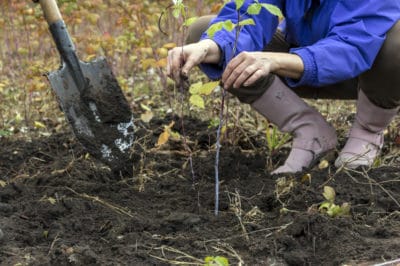What to Transplant
The roots of a healthy raspberry bush send out suckers that become new plants. These often grow 2-3 feet away from the original plant and outside the hedgerow or hill. These new sucker plants can safely be separated from the roots and become a thriving fruit-producing bush on its own.
Best Time to Transplant
Raspberry bushes become dormant every year. The time of dormancy varies depending on the growing location. Most raspberry bushes are dormant in early spring or late fall. Dividing the plant at this time reduces plant stress due to the inactivity of the plant.
If transplanting in the early spring, divide the plant as soon as the soil can be worked. Do not divide and transplant after the plant actively begins to grow. Never transplant in the summer. This can disturb the fruiting canes and reduce the crop size.
The late fall is also a good time to divide and transplant raspberry plants. When the raspberry canes have finished bearing fruit and have shed their leaves, it is safe to divide and transplant.
Where to Transplant
The best raspberries grow in a soil that has been prepared for one year. Adding and then allowing the compost to break down in the soil will produce a soil full of the nutrients needed for thriving raspberry bushes.
How to Transplant
When the original raspberry plants are dormant and a new planting area is prepared, it is time to transplant the sucker plants. Here are the transplanting steps:
- Using a shovel, cut into the soil about 4-6 inches away from a sucker plant.
- Carefully lift the young sucker plant and its surrounding soil.
- Using sharp shears, separate the sucker plant from the original plant.
- Dig a 6-8 inch deep hole with a diameter slightly larger than the sucker plant root system.
- Fill the hole with water.
- Insert the new plant into the hole.
- With the crown of the plant just below the ground level, fill in the hole with loose soil.
- Gently yet firmly, press the soil around the plant.
- Using sharp shears, cut the plant’s cane just above a bud, leaving 9-12 inches of cane above the ground.
With proper watering, this new plant will soon be producing fruit. This transplanting process can be repeated over and over again. Before long you can have a raspberry patch bigger than you have ever dreamed of.
